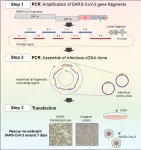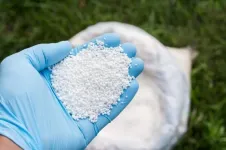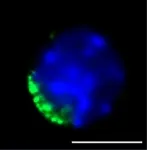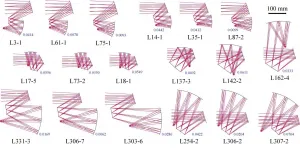SUTD breaks new ground in 3D printed soft robotics with largest range of polymer hybrids
These newly developed resins are tougher and will also allow for more robust integration of mechatronic components in 3D printed multi-material structures.
2021-04-13
(Press-News.org) In a study published in Applied Materials Today, researchers from Singapore have developed the largest range of silicone and epoxy hybrid resins for the 3D printing of wearable devices, biomedical equipment, and soft robotics. The range of tunable functionally graded materials, which displayed over five orders of magnitude of elastic modulus, demonstrated excellent interfacial toughness, higher precision in complex structures and better fabrication control for the integration of mechatronic components.
The multi-disciplinary team from the Singapore University of Technology and Design (SUTD) highlighted the issue on the potential of soft robotics being limited in its robustness and applicability in their paper, 'Silicone/Epoxy Hybrid Resins with Tunable Mechanical and Interfacial Properties for Additive Manufacture of Soft Robots'.
For instance, the integration of mechatronic components such as printed circuit boards (PCB), sensors, batteries, pneumatic fittings, cables and pumps, into soft and composite bodies continue to be a challenge, while design complexity and fabrication control are hindered by the traditional molding and casting approaches used for integration.
To address these limitations, the team developed a novel range of polymer hybrids which can exhibit a wide range of mechanical characteristics from very soft to very stiff for use in soft robotics and easier assembly in traditional hard mechatronics components respectively. The polymer hybrids display excellent toughness and chemical compatibility to withstand large strains, and be processable via direct-ink writing to allow advanced digital manufacturing of complex structures.
The range of novel silicone-epoxy hybrids were made of soft platinum-catalyzed elastomers and hard epoxy resins cured by acid anhydride hardeners. Choosing acid anhydrides instead of commonly used amine-based hardeners allowed for an unprecedented chemical compatibility between silicone and epoxy phases, and also enabled precise tuning of mechanical and interfacial characteristics by varying its compositions.
The resulting family of hybrids displayed over five orders of magnitude of elastic modulus, ranging from 22 kPa to 1.7 GPa, which is probably the largest range reported for tunable functionally graded materials. Composites with close composition exhibit excellent interfacial toughness from 0.8 to 3.0 kJ.m-2, enabling robust interfaces between soft bodies and a wide range of traditional mechatronic components. The addition of rheological modifiers - in this case, laponite nanoclay - to ink formulations enabled the additive manufacturing of complex three-dimensional composite structures (refer to image and video).
The advantages of this new family of hybrids were demonstrated through four main examples. First, a PCB was integrated to a soft membrane that could be stretched more than 200% without displaying any interfacial damage. Second, a finger articulation was successfully reproduced from anatomical models, with robust integration of bone-like, tendon-like, and ligament-like structures. Then, the structure and performance of reinforced pneumatic actuators with tunable axial deformations was detailed. Finally, a bat-inspired wing structure capable of supporting fast dynamics and large bending deformations was reported.
The performances in these examples could only be achieved due to the advanced fabrication approach that enabled the robust combination of materials at multiple scales and high resolutions that traditional casting or molding approaches could not attain.
"The findings and the understanding derived from this work, at the interface of chemistry, physics, and engineering, represent a substantial contribution to materials engineering especially when applied to soft robotics. Our advanced fabrication approaches facilitate robust material combinations at multiple scales and high resolutions enabling novel applications to a broad range of key sectors, such as wearables, healthcare, and more specifically soft robotics," said principal investigator Assistant Professor Pablo Valdivia y Alvarado from SUTD's Engineering Product Development programme.
INFORMATION:
ELSE PRESS RELEASES FROM THIS DATE:
2021-04-13
Osaka, Japan - SARS-CoV-2 is the virus responsible for the COVID-19 pandemic. We know that mutations in the genome of SARS-CoV-2 have occurred and spread, but what effect do those mutations have? Current methods for studying mutations in the SARS-CoV-2 genome are very complicated and time-consuming because coronaviruses have large genomes, but now a team from Osaka University and Hokkaido University have developed a quick, PCR-based reverse genetics system for analyzing SARS-CoV-2 mutations.
This system uses the polymerase chain reaction (PCR) and a circular polymerase extension reaction (CPER) to reconstruct the full-length cDNA of viral genome. This process does not involve the use of bacteria, which can introduce further ...
2021-04-13
In the 1930s, English climatologist, Sir Gilbert Walker, successfully predicted Indian summer monsoon rainfall (ISMR) based on the relationship between Southern Oscillation and ISMR connected by what is later-called Walker circulation, which is regarded as the first achievement of modern climate prediction with a clear physical mechanism. The Southern Oscillation was also recognized as the atmospheric component of El Nino-Southern Oscillation (ENSO).
However, at the end of the 20th century, a research in Science led by Indian climatologist Krishna Kumar found the significant reverse relationship between ENSO and Indian rainfall has been ...
2021-04-13
Ammonia (NH3) is among the most important chemicals produced by humans and has a promising future in sustainable energy applications besides being used in fertilizer production. Unfortunately, so far, the only realistic way that exists to produce ammonia at an industrial scale is through the Haber-Bosch process. This technique, discovered in the 19th century, is very energy-intensive and environmentally unfriendly; about 2% of the yearly global CO2 emissions come from Haber-Bosch processes.
"Considering the threats posed by global warming, it is high time we swap to an ammonia synthesis route with zero CO2 emissions," says Professor Sangaraju Shanmugam from Daegu Gyeongbuk Institute of Science and Technology (DGIST), Korea. ...
2021-04-13
What started out as a second-year physics project is making its way into Amazon Web Service's (AWS) quantum computing program.
University of Sydney science undergraduate Pablo Bonilla Ataides has tweaked some computing code to effectively double its capacity to correct errors in the quantum machines being designed in the emerging technology sector.
The simple but ingenious change to quantum error correcting code has grabbed the attention of quantum researchers at the AWS Center for Quantum Computing in Pasadena, California, and the quantum technology programs at Yale University and Duke University in the United States.
"Quantum technology is in its infancy, partly because we haven't ...
2021-04-13
CORVALLIS, Ore. - A new study by Oregon State University researchers found that shade provided by solar panels increased the abundance of flowers under the panels and delayed the timing of their bloom, both findings that could aid the agricultural community.
The study, believed to be the first that looked at the impact of solar panels on flowering plants and insects, has important implications for solar developers who manage the land under solar panels, as well as agriculture and pollinator health advocates who are seeking land for pollinator habitat restoration.
The findings, ...
2021-04-13
Durham, NC - When leukemia strikes an older person, it is in part due to the aging of his or her hematopoietic stem cells (HSCs). These immature cells can develop into all types of blood cells, including white blood cells, red blood cells and platelets. As such, researchers have focused on rejuvenating HSCs as a way to treat leukemia.
A new study released today in STEM CELLS adds much to that level of knowledge by showing that the youthful function of rejuvenated HSCs upon transplantation depends in part on a young bone marrow "niche," which is the microenvironment surrounding stem cells that interacts with them to regulate their fate.
"The information revealed by our study tells us that the influence of this niche ...
2021-04-13
Ancient clues, in the shape of fossils and archaeological evidence of varying quality scattered across Australia, have formed the basis of several hypotheses about the fate of megafauna that vanished about 42,000 years ago from the ancient continent of Sahul, comprising mainland Australia, Tasmania, New Guinea and neighbouring islands.
There is a growing consensus that multiple factors were at play, including climate change, the impact of people on the environment, and access to freshwater sources.
Now, research led by Professor Corey Bradshaw of Flinders University and the Australian Research Council Centre of Excellence of Australian Biodiversity and Heritage (CABAH) has used sophisticated mathematical modelling to assess how susceptible different species were to extinction - and what ...
2021-04-13
April 13th, 2021, Washington, D.C. - The severe health and economic impacts of the COVID-19 pandemic have disrupted food systems and upended livelihoods. Yet pandemic responses have demonstrated the power of well-crafted policies to blunt the impact of major shocks while laying the groundwork for stronger, more resilient food systems, according to the 2021 Global Food Policy Report, released today by the International Food Policy Research Institute (IFPRI). The report provides lessons drawn from the current crisis that can help us transform food systems to reduce the impact of the ongoing pandemic, better prepare for future shocks, and address longstanding weaknesses and inequalities.
"We have known ...
2021-04-13
In the early time of optical design, people have to be proficient in aberration theory and perform a huge amount of numerical calculations, and thus mathematical skills and talents are very important. The emergence of electronic computers has freed people from heavy calculation tasks, and realized fast real ray tracing and been able to solve complex aberration equations. Since then, the application and development of optimization algorithms and optical design software have greatly improved the speed and effect of optical design. However, optical design still requires to solve or find an initial solution as the starting point of optimization, which will greatly determine the final result of optimization. Moreover, optimization is essentially ...
2021-04-13
The top priority in the field of transplantation is to ensure that donor organs are allocated to the patients with the greatest need.
In a large-scale joint international project conducted by the Medical University of Vienna and the Mayo Clinic in Rochester (USA), researchers from the Department of General Surgery and the Division of Gastroenterology and Hepatology of MedUni Vienna's Department of Medicine III, have made a significant step forward to improve prediction of survival on the waiting list for liver transplantation by including additional laboratory parameters.
Donor ...
LAST 30 PRESS RELEASES:
[Press-News.org] SUTD breaks new ground in 3D printed soft robotics with largest range of polymer hybrids
These newly developed resins are tougher and will also allow for more robust integration of mechatronic components in 3D printed multi-material structures.







